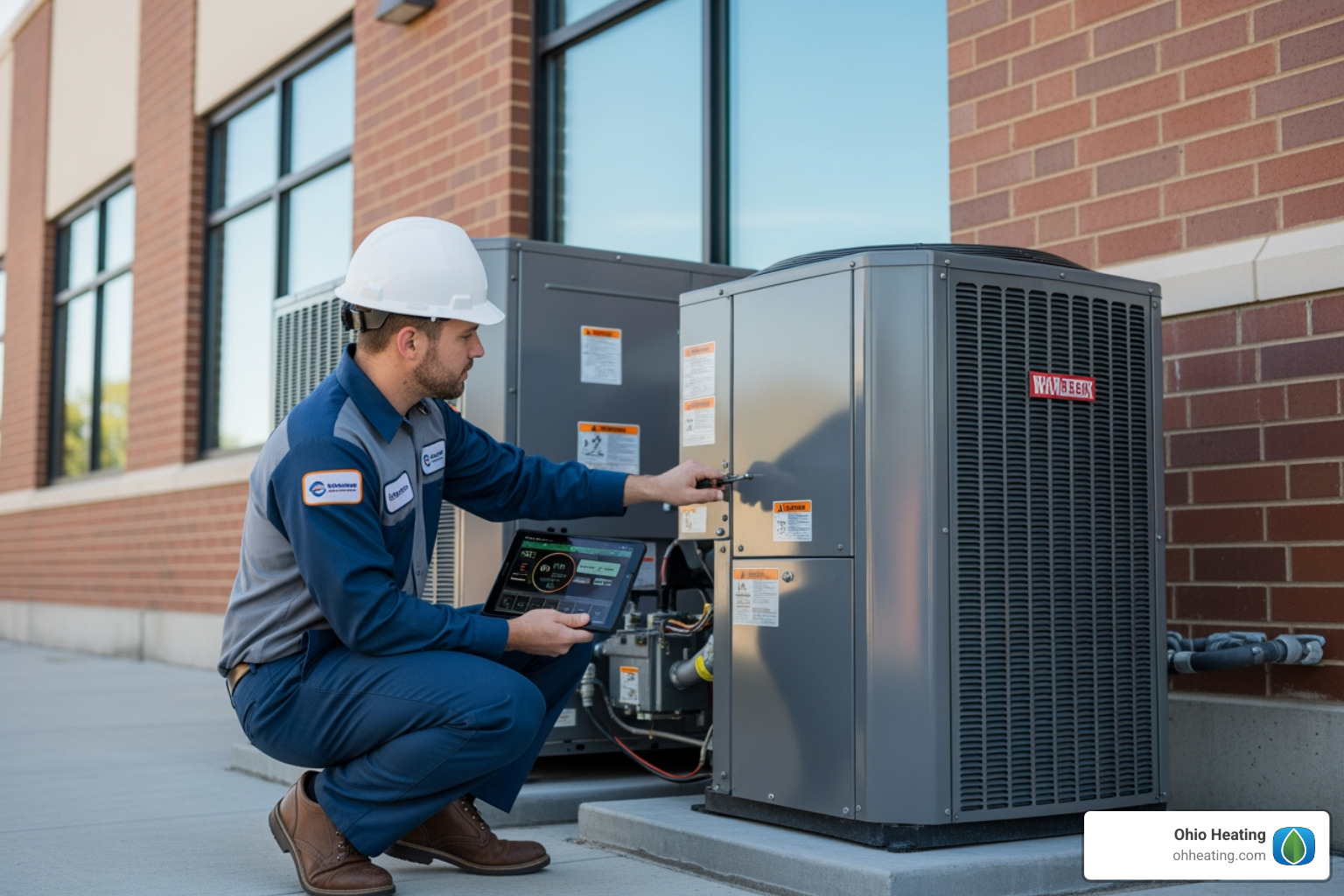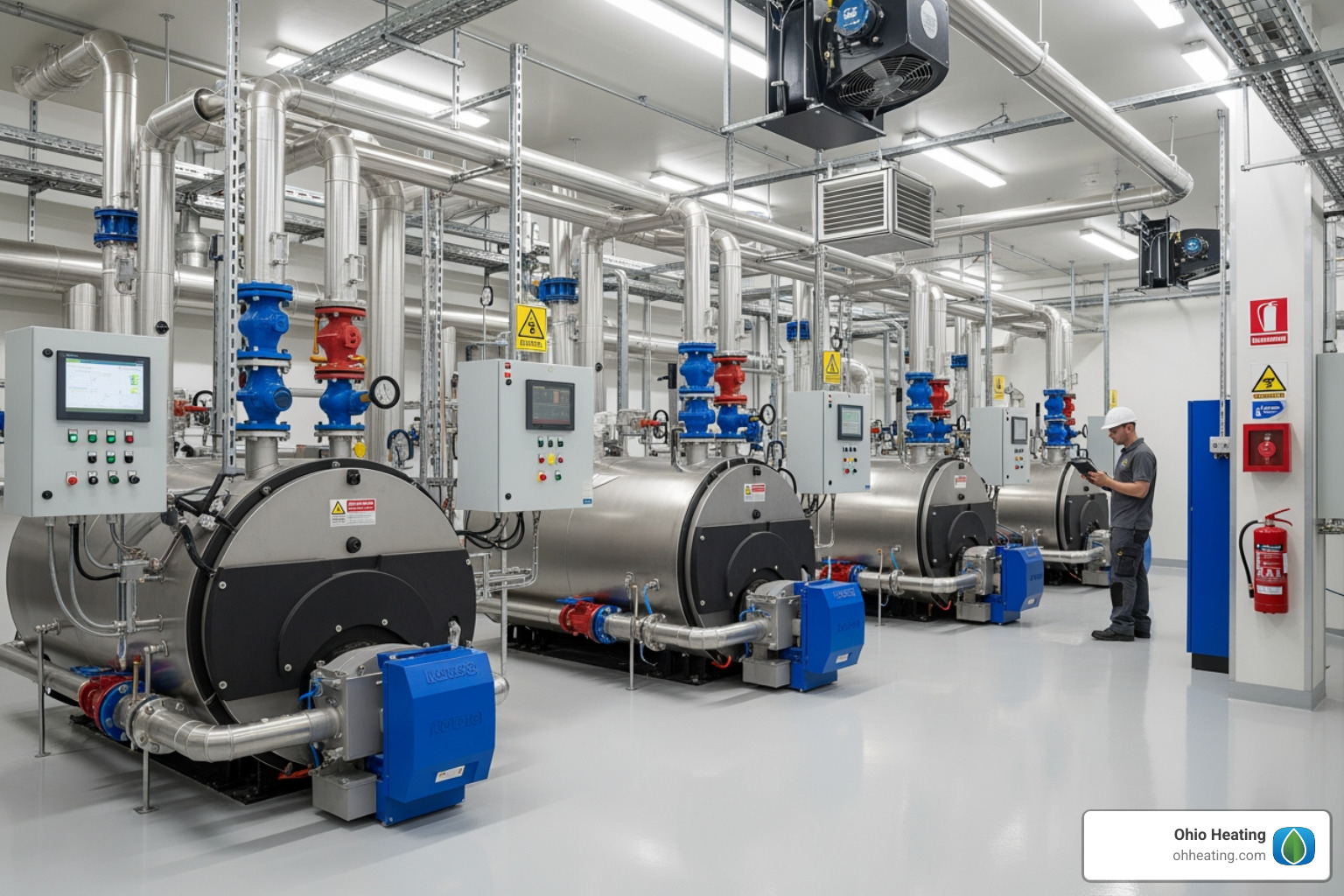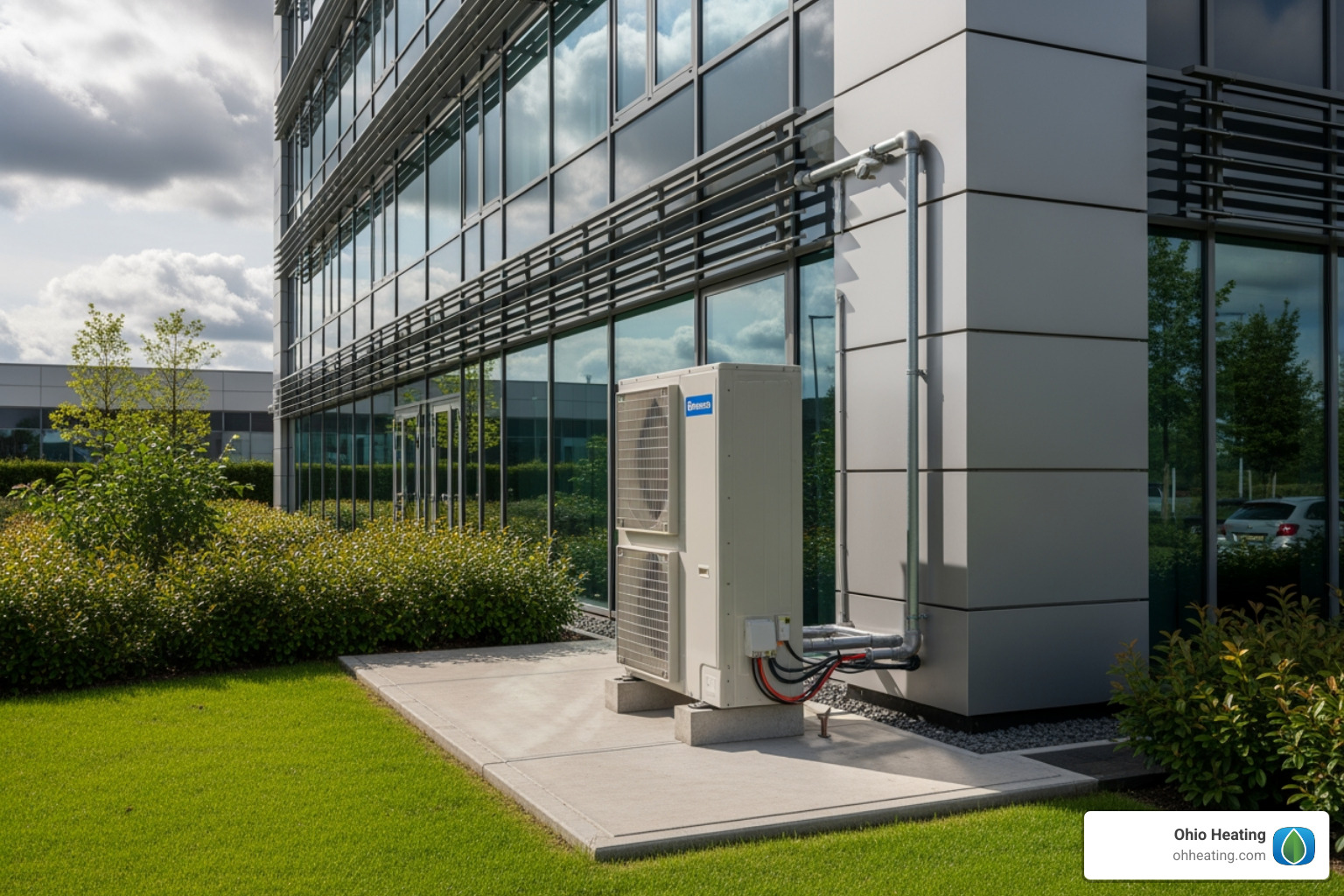Heating solutions for businesses: Best Options 2025
Why Your Business Heating System is More Than Just Comfort
Choosing the right heating solutions for businesses is a critical decision that impacts employee productivity, operational costs, asset protection, and business continuity during Ohio’s harsh winters. A system failure during a cold snap can lead to downtime, damaged inventory, and lost revenue.
Quick Answer: Main Commercial Heating Options
| System Type | Best For | Key Benefit |
|---|---|---|
| Forced Air Systems | Offices, retail shops | Quick heating, easy AC integration |
| Hydronic Systems | Hospitals, schools, warehouses | Even heat, high efficiency for large spaces |
| Heat Pumps | Modern facilities seeking efficiency | Up to 400% efficiency, heating + cooling |
| Infrared Heating | Warehouses, open areas | Direct spot heating, energy savings |
The right heating solution balances upfront costs with long-term efficiency, as heating accounts for around 10% of all non-transport energy in commercial buildings. A poorly chosen or improperly sized system can lead to high energy bills, frequent breakdowns, and a shortened equipment lifespan.
Fortunately, modern technology offers significant advancements. Heat pumps can achieve efficiencies of 300-400%, delivering three to four units of heat for every unit of electricity. These new systems often pay for themselves through energy savings.
This guide covers everything from assessing your needs to exploring traditional and modern heating options.
Key Factors in Selecting Your Commercial Heating System
Picking the right heating solution for your business in Columbus requires a custom approach, as every building is unique. The system for a small café won’t work for a large warehouse. Key factors must be carefully evaluated.

- Building Size and Layout: Open-plan offices, multi-floor retail spaces, and high-ceiling warehouses have vastly different heating requirements.
- Insulation Quality: A well-insulated building retains heat, reducing the workload on your system and lowering energy bills. Poor insulation is like heating a building with the windows open.
- Local Climate: Ohio’s cold winters demand a system robust enough to handle sustained low temperatures, unlike systems designed for milder climates.
- Budget: Consider both upfront versus long-term costs. A cheaper initial system may cost more over its lifespan in energy and repairs than a high-efficiency model.
- Energy Efficiency Goals: Your goals, whether to cut utility bills, reduce your carbon footprint, or meet sustainability standards, will guide technology choices.
- Zoning Requirements: If different areas have different heating needs or schedules (e.g., offices vs. a warehouse), zoning allows for independent control and significant energy savings.
For a deeper dive, see our guide on assessing your building’s needs.
How to Assess Your Current Heating Needs
Before choosing a new system, a thorough assessment is crucial.
- Energy Audit: This goes beyond utility bills to identify heat loss, check system performance, and pinpoint inefficiencies in windows, walls, and equipment.
- Heat Load Calculation: This technical calculation determines the precise heating power your building needs, factoring in square footage, ceiling height, windows, occupancy, and more. Getting this right prevents an undersized or oversized system, both of which waste energy.
- Existing Infrastructure: Evaluating your current ductwork or piping is essential. We determine if it can be reused or if a fresh start is more cost-effective.
- Operational & Future Needs: A 24/7 facility has different requirements than a 9-to-5 office. We also consider future growth to ensure your system can scale with your business.
Getting this assessment right ensures your new heating solution for your business is a perfect fit. For more on optimizing performance, learn about energy management.
The Impact of Fuel Sources on Efficiency and Cost
The fuel you choose affects operating costs, environmental impact, and system options.
- Natural Gas: Widely available and affordable, it provides quick, consistent heat. Prices can fluctuate, and it is a fossil fuel.
- Propane: An option where natural gas isn’t available, stored on-site for energy independence. Prices can be more volatile, and it requires tank maintenance.
- Electricity: Clean on-site and universally available. While traditionally more expensive per unit of heat, it becomes highly cost-effective when paired with ultra-efficient heat pumps.
- Kerosene: A niche fuel for specialized applications like warming construction sites or keeping diesel fuel from gelling in winter.
- Biomass: A renewable option using wood pellets or chips, ideal for businesses committed to carbon neutrality. It requires fuel storage and ash removal.
Choosing a fuel involves balancing cost, availability, and your business’s long-term sustainability goals.
A Deep Dive into Traditional Heating Solutions for Businesses
Traditional heating solutions for businesses are proven workhorses that continue to serve countless commercial spaces effectively. Understanding these reliable systems is key to making an informed choice.

Forced air systems are ideal for offices and retail, offering quick heat. Hydronic systems excel at providing even, consistent warmth in large buildings like hospitals and schools. Infrared heating offers a targeted approach for open areas like warehouses, heating objects and people directly to save energy.
Here’s how these three workhorses stack up:
| System Type | Initial Cost | Operating Efficiency | Best Use Cases | Maintenance Needs | Lifespan |
|---|---|---|---|---|---|
| Forced Air | Moderate | Good | Offices, Retail, Restaurants | Moderate (filters, duct checks) | 15-20 years |
| Hydronic (Boilers) | High | Excellent (large spaces) | Hospitals, Schools, Industrial | Moderate (boiler checks, piping) | 20-30+ years |
| Infrared | Moderate | Good (targeted) | Warehouses, Loading Docks, Patios | Low | 10-20 years |
Forced Air Systems: Furnaces and Packaged Units
Common in offices and retail, forced air systems heat spaces quickly. A central furnace or packaged unit heats air, and a fan distributes it through ductwork. This rapid response time keeps employees and customers comfortable. Key benefits include integrated air filtration, improving indoor air quality, and seamless integration with air conditioning using the same ductwork. Rooftop units (RTUs) are a popular variation, saving valuable interior space by housing all components on the roof. For expert service, see our Commercial rooftop unit services. The main consideration is the need for ductwork, which can add costs in older or uniquely laid-out buildings.
Hydronic Systems: Boilers and Radiant Heat
Hydronic systems provide a gentle, enveloping warmth by circulating hot water or steam from a boiler through pipes to radiators or in-floor tubing. This results in remarkably consistent, even heat without the drafts sometimes associated with forced air. These systems are exceptionally efficient and reliable for large applications like hospitals, schools, and industrial facilities. A well-maintained commercial boiler can last 20 to 30 years or more, offering a significant return on investment. They also allow for excellent zoning capabilities, enabling different temperatures in different areas to save energy. We provide Expert commercial boiler services to keep your system at peak performance.
Infrared Heating: A Targeted Approach
Infrared heating works like sunlight, warming objects and people directly rather than the air. Infrared heaters emit electromagnetic waves that convert to heat upon contact with a solid surface. This is a brilliant heating solution for businesses with high ceilings or large open spaces, such as warehouses, loading docks, and manufacturing floors. Instead of trying to heat a massive volume of air, you create comfortable “warm zones” exactly where needed, leading to substantial energy savings. Another benefit is silent operation, as there are no fans. For specific applications, infrared heating delivers targeted comfort and cost savings that traditional systems can’t match.
The Future is Efficient: Modern and Renewable Heating Options
The world of heating solutions for businesses is shifting toward smarter, more efficient systems that lower running costs and reduce environmental impact. This trend, known as beneficial electrification, involves switching from fossil fuels to high-efficiency electric systems that can leverage an increasingly clean power grid.

The benefits include lower operating costs, a smaller carbon footprint, and future-proofing your business against changing regulations. The U.S. Department of Energy offers Guidance on electrifying commercial buildings for those considering this transition.
High-Efficiency Heat Pumps: The All-in-One Solution
Heat pumps are a compelling modern heating solution for businesses due to their remarkable efficiency and versatility. Instead of creating heat, they move it. In winter, they extract heat from the outside air (even cold air) and transfer it indoors. In summer, they reverse the process for cooling.
This process allows them to achieve efficiencies of 300-400%, delivering 3-4 units of heat for every unit of electricity used. This can cut heating costs by 50% or more compared to natural gas or traditional electric systems.
Commercial options include:
- Mini-split heat pumps for zoning specific areas without ductwork.
- Packaged heat pump units for whole-building comfort, similar to RTUs.
- Variable Refrigerant Flow (VRF) systems for complex buildings, allowing simultaneous heating and cooling by transferring heat from one zone to another.
While modern cold-climate heat pumps perform well in low temperatures, some may require a supplemental heat source during Ohio’s coldest days. For year-round peak efficiency, we also offer Water source heat pumps in Columbus, Ohio.
Renewable Heating Solutions for Businesses
For businesses aiming to reduce fossil fuel use, several renewable options exist.
- Solar Thermal Systems: Rooftop collectors capture sunlight to heat water for domestic use or space heating, offsetting energy consumption, particularly on sunny days.
- Biomass Boilers: These systems burn renewable fuels like wood pellets or chips, offering a carbon-neutral heat source comparable to traditional boilers. They are suitable for larger facilities but require fuel storage and ash removal.
- Geothermal Systems: By using the earth’s constant underground temperature, these systems provide incredibly efficient heating and cooling. The upfront installation cost is high, but operating costs are exceptionally low, offering an excellent long-term ROI.
We provide specialized Geothermal solutions in Columbus, Ohio for businesses ready to invest in this sustainable technology.
Optimizing Your Entire HVAC System for Peak Performance
Your heating system is part of a larger ecosystem including ventilation and controls. For heating solutions for businesses to deliver peak performance, they must be integrated with proper ventilation and receive regular maintenance. A holistic approach prevents issues like a new furnace losing heat through leaky ducts, ensuring you get the efficiency you paid for.
This integrated strategy also improves employee comfort and productivity. A comfortable team is a focused team. Protecting your investment with regular maintenance is essential for efficiency and longevity, preventing small issues from becoming costly emergencies. Learn more about The importance of regular maintenance.
The Role of Commercial Ventilation
Proper ventilation is your heating system’s essential partner. Bringing in fresh air is vital for health, but heating cold winter air is energy-intensive. Smart ventilation technology solves this problem.
- Dedicated Outdoor Air Systems (DOAS): These units manage all fresh air needs separately, pre-conditioning it to the right temperature and humidity before delivery. This reduces the load on your primary HVAC system.
- Energy Recovery Ventilators (ERVs): As stale, warm air is exhausted, ERVs transfer its heat to the incoming cold, fresh air. This preheating dramatically reduces the energy your heating system needs to use.
- Make-Up Air Units: Critical for kitchens and industrial facilities, these units replace air removed by exhaust systems. This prevents negative pressure, which can pull in unconditioned air and create safety hazards.
Good ventilation supports your heating system, improves air quality, and creates a healthier environment. We offer comprehensive Our ventilation system services to optimize your building’s airflow and energy use.
Leveraging Financial Incentives and Rebates
Upgrading your heating solution for your business can be more affordable than you think. Significant financial help is often available through federal tax credits, state programs, and utility company rebates for businesses investing in energy-efficient equipment.
- Federal Tax Credits: Can substantially reduce your tax liability for qualifying HVAC installations.
- State and Local Programs: Ohio and the Columbus area may offer grants, low-interest loans, or direct incentives for energy reduction.
- Utility Rebates: Companies like AEP Ohio and Columbia Gas of Ohio often provide cash rebates for installing high-efficiency equipment.
Navigating these programs can be complex, as requirements and deadlines vary. We help our clients identify and apply for these incentives, which can dramatically improve your return on investment by shortening the payback period for a new system. Don’t leave money on the table; ask us about current programs when planning your upgrade.
Frequently Asked Questions about Commercial Heating
Here are answers to the most common questions we hear from Columbus business owners and facility managers about their heating systems.
What are the most common signs that my business needs a new heating system?
Knowing when to replace your system can save you from costly emergency repairs and high energy bills. Look for these red flags:
- Rising Energy Bills: If costs are climbing without a change in usage, your system’s efficiency is declining.
- Uneven Heating: Hot and cold spots throughout your building indicate poor heat distribution and wasted energy.
- Frequent Breakdowns: If you’re calling for repairs multiple times a season, the cumulative cost and downtime may justify a replacement.
- System Age: Most commercial systems last 15-20 years. If yours is approaching this age, it’s likely inefficient compared to modern units.
- Strange Noises: Grinding, banging, or squealing sounds often signal failing mechanical components.
Ignoring these signs can lead to system failure on the coldest day of the year. For more information, see these Common causes of system failure.
How do I choose the right size heating system for my commercial space?
Sizing is absolutely critical for an effective heating solution for your business. An improperly sized system, whether too large or too small, will perform poorly and waste money.
- An oversized system will “short cycle”—turning on and off frequently. This wastes energy, creates temperature swings, and causes excessive wear on parts.
- An undersized system will run constantly without being able to reach the target temperature, leading to high bills and premature failure.
To avoid these issues, a professional load calculation is necessary. This detailed analysis considers your building’s square footage, ceiling height, insulation, windows, occupancy, and local climate data to determine the exact heating capacity required. This is the foundation of an efficient and cost-effective system.
How often should a commercial heating system be serviced?
Regular maintenance is essential to keep your heating solution for your business running reliably and efficiently. Think of it as preventative care for a critical business asset.
We recommend professional service at least annually, ideally in the fall before the heating season begins. For systems that also provide cooling, bi-annual checks (spring and fall) are the gold standard. During a service visit, technicians inspect, clean, and test all components to ensure safety and peak performance.
Regular maintenance lowers energy bills, improves indoor air quality, prevents costly breakdowns, and extends the lifespan of your equipment. The investment pays for itself through savings and reliability. Explore our Maintenance Plans designed for commercial properties.
Your Partner for Reliable Commercial Heating in Columbus
Choosing the right heating solution for your business is a critical investment. The best system—whether a traditional boiler or a modern heat pump—depends on a thorough assessment of your building’s unique needs, budget, and operational goals.
This decision impacts your operating costs, employee productivity, and business continuity during Ohio’s winters. It’s not a choice to be made lightly.
Since 1999, Ohio Heating has helped businesses across Columbus and Central Ohio make these important decisions. We don’t push one-size-fits-all products; we listen, assess, and recommend the solution that makes the most sense for you. From professional load calculations and expert installation to ongoing maintenance and emergency repairs, our goal is to ensure your comfort and operational reliability.
Ready to find the right heating solution for your business? Explore our comprehensive commercial HVAC services and let’s start a conversation.
